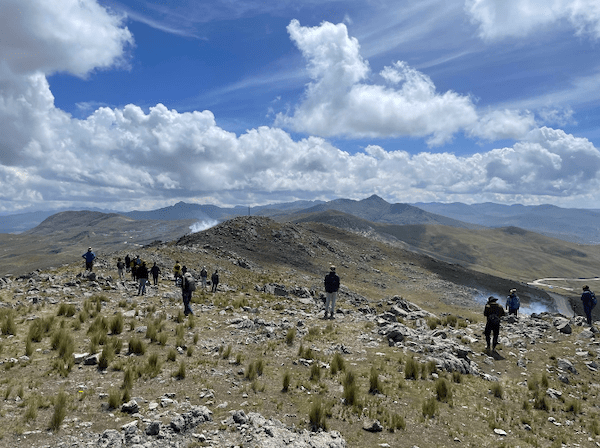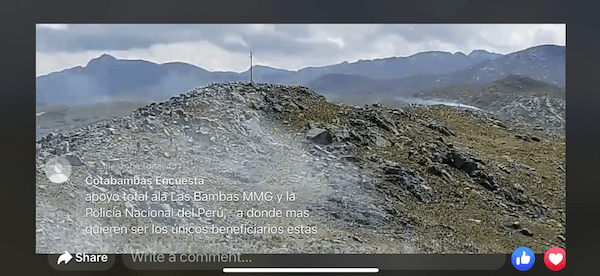This piece explores how the indexical quality of Facebook livestreams and the particular claims they make to represent or manifest “reality” connect with long-standing anxieties over accountability, transparency and trustworthiness in contexts of profound distrust and extreme socioeconomic inequality. Across Peru’s southern Andes, peasant community leaders have taken to livestreaming roadblocks, marches, and corporate negotiations amidst the rapid transformation of their ancestral lands into one of the most lucrative and promising sites for large-scale, industrial mineral extraction in Latin America. Using digital anthropology methods, I trace how livestreams have emerged as a vibrant, albeit unstable, political form for cultivating trust in a political system that has historically failed to respond to the demands of the Andean communities that speak as el pueblo, or “the people.”
“We bet on mining,” peasant leaders (dirigentes) say of the decision to permit one of the world’s largest open-pit copper mining projects on lands occupied by Quechua-speaking communities in Peru’s southern Andes some ten years ago. Although intermittent signs of nouveau wealth now glint amidst dusty mountains, the glaring absence of prosperity in these rural Andean communities suggests that the gamble on large-scale extraction is unlikely to pay off. “We have so much wealth; why do we continue to be poor?” Residents of peasant communities bemoan, caught between disbelief and disappointment. In the gap between intensive extraction and few palpable improvements in peasant quality of life, a pervasive sense of desconfianza (distrust) in local leaders has emerged. Rather than concluding that extraction cannot produce sustainable growth, the absence of the massive social development promised by the mine has instead made dirigentes into objects of intense suspicion and popular critique.
Much to the chagrin of many dirigentes, they, not the mining company, are held responsible for the mega-mine’s failure to produce appreciable forms of prosperity. The people’s defenders (luchadores sociales) thus find themselves confronting rumours that they are, in fact, the enemies of the people (enemigos del pueblo). It is in this context of profound desconfianza that Facebook livestreams appear as a promising technology of trust for dirigentes seeking to legitimize themselves, to justify their efforts to renegotiate the terms of mining activity, and to recuperate the population’s faith in them and their lucha por el pueblo (fight for the people). Using livestreams, dirigentes document community protests, negotiations with mining companies, and dialogue meetings with state authorities in real time. As one livestreaming dirigente explained: “If the people [población] can see what you are doing, if they know the reality, then how can you be doing anything wrong?”

This piece explores how technologies like Facebook livestreams intersect with seductive assumptions about the links between visibility, transparency, and accountability. It does so by examining the ambivalent effects of peasant leaders’ adoption of livestreams and the ways in which these recordings exceed dirigentes’ efforts to direct how they are interpreted. Through social media, dirigentes aim to make their political labour more open, transparent, and visible, thus combatting accusations of corruption and (ideally) restoring popular trust in their advocacy for fellow peasants. But because livestreams operate under the proposition that “video…has a privileged access to objective truth” (Razsa 2014:507, paraphrasing Mazzarella 2004), they make “reality” a salient battleground both for those challenging large-scale extraction in Peru’s southern Andes and those who support it. The documentarian quality of livestreams that draws in dirigentes is the very same which appeals to sceptics, who use the visuals and sound bites from these real-time videos as “proof” (“medio probatorio”) about the “truth” behind dirigentes’ political actions: that they are motivated by avarice and ignorance, and that their protests of mining activity are little more than extortion disguised as social struggle (Facebook comment, August 1, 2022).
During a two month-long protest in early 2022, dirigente livestreams from communities around the mine showed police launching dozens of tear gas canisters at community members armed with warakas, a kind of woven sling used to herd sheep and cows. As one dirigente explained in his livestream, “we [are] able to bear witness to the abuses of the National Police… it seems that the mining company is betting on repression of these peasant communities with which they have unfulfilled promises…[to] manag[e] these kinds of conflicts.” Through tear gas, the dirigente went on:
We will continue to livestream…[so] that [our situation] may reach, first-hand, the entirety of our province, our region, our country, and internationally. We make an effort to livestream, to share [colaborar con] information so that you all may know first-hand [what is happening]…Social media is a joy and a possibility for us [because] it permits us to inform you all of what is really happening, first-hand…[Through livestreams we can] bring to you first-hand information from the very place where things are happening (Facebook, April 28, 2022).
In their voiceovers on these livestreams, dirigentes claim to reveal the mine’s “real” face: violent, intractable, and unconcerned with peasant well-being. This ability to speak authoritatively on behalf of peasant realities is rooted in livestreams’ indexical quality, the “grounds for viewers’ frequent belief that the image and sound of photographic, filmic and video recordings are simply the world presented directly, i.e. a direct and objective truth without mediation” (Razsa 2014:507, paraphrasing Mazzarella 2004). The livestream’s power thus lies in its apparent ability to transmit things as they “really are,” “first-hand,” in “the place where things are happening.” Under the auspices of unmediated access to “reality,” livestreams offer dirigentes the promise of being able to narrate and interpret reality in a way that shows the abuses of an extractive industry-military complex and which supports their demand to renegotiate the current terms of mining activity for more just conditions.
The livestream’s power thus lies in its apparent ability to transmit things as they “really are,” “first-hand,” in “the place where things are happening.”
In other words, dirigente editorializing seeks to seize control of the process through which the raw material of reality is transformed into some representation of what is “real.” Rather than oppose representations of reality to some objective reality “out there” in which the former is “false” and the latter is “true,” I view dirigente livestreams as narrations that operate under the sign of “reality.” Albeit subjective, their narrations disrupt other dominant narrative arcs that seek to conceal the violence and contradictions required to make large-scale mining activity possible and continually desirable. However, to the dismay of livestreaming dirigentes, “reality” operates like any other sign: open to contestation, interpretation, and re-signification, in ways that may be unexpected and disconcerting (see Goodwin 1994; Gal and Irvine 2019).
Facebook livestreams are especially vulnerable to practices that reroute meaning towards competing interpretations because comments made during the livestream appear on the screen in real-time, narrating the events taking place as they happen. Since anyone can comment on these livestreams, dirigentes have virtually no control over how these (often anonymous) commenters narrate the livestream’s “reality.” Moreover, livestreams watched after they were originally streamed retain these comments as if they were subtitles on past events, in which “these comments form part of [the livestream as] a circulating visual document…[and] provide a pointed frame” for how future viewers should interpret what they see (Zhang, forthcoming).
To the dismay of livestreaming dirigentes, “reality” operates like any other sign: open to contestation, interpretation, and re-signification, in ways that may be unexpected and disconcerting (see Goodwin 1994; Gal and Irvine 2019).
For instance, in one livestream of a meeting to negotiate the end of the two-month long protest which paralyzed the mine, various rolling comments claimed to know the truth behind dirigentes’ motivations. Real-time commentary subtitled the livestream with claims like: “The reality is that the community members want money” and “Do you know[?] the reality is that these s[hits] want money, period” (Facebook, June 9, 2022). These comments drew on the dirigentes’ own displayed behaviour in the livestreams to substantiate their claims, asserting that “This [dirigente and his community] is crazy for money. They have money and are businessmen [which makes] them think they are better than others. But if they were [really] poor they wouldn’t act like this[,] petulant Because the poor are humble and speak [differently, using] pleas/supplication These [guys] have been [trained]” (ibid). Another scoffs in the rolling comments, “What nice phones these so-called ancestral peasants use” (ibid). Pointing out how dirigentes behave, look, and speak in these meetings as evidence that they are not who they say they are or that their motivations are distinct from the ones they manifest readily slips into accusations that their underlying opposition to the mine is also uncredible.
In a previous livestream of a press conference with the protesting communal leaders, someone wrote, “This is a band of cattle-rustlers and racketeers. The only thing [these dirigentes] are after is more money by extorting mining companies…They are only disguised [dressed up; “disfrasados”] as ‘peasants’ [“comuneros”]” (Facebook, June 2, 2022). By using the very same videographic evidence of a reality that dirigentes believe will endorse their marches and strikes to instead “prove” that dirigentes are secretly motivated by “other interests…like greed,” these other claims to know “reality” generate further desconfianza, not just towards dirigentes but also to undercut the notion that opposition to extraction is even legitimate to begin with. Through Facebook livestreams, protests are re-signified by a mistrustful audience as extortion (chantaje): “These old guys [dirigentes] have discovered how to get money from the mine…[by] blocking it for any old bullshit [reason]” (ibid). Showing things “as they are” has turned out to be a dicey proposition as livestreams attract what dirigentes consider to be “trolls”: anonymous accounts that use a livestream’s rolling comment section to “chancar” (browbeat; critique; attack) and accuse peasant communities and their leaders of organizing roadblocks to extort the mining company for payoffs. The “reality” that livestreams threaten to reveal is therefore not, as dirigentes imagined, the exploitation and abuses of the mine, but the avarice and hypocrisy of dirigentes themselves.

While it is difficult to assess whether (or how many) viewers are influenced by these social media posts, the chatter is enough for some dirigentes to restrict livestreaming or even grow suspicious of those who livestream. Efforts to use livestreams to generate confianza have only undermined it further, it seems. Seeing screenshots taken from livestreams alongside salacious captions has led to confusion and even accusations among dirigentes that those who livestream are also secretly running Facebook pages dedicated to undermining their fight against the unfair terms of mining activity. These anonymous posts reinterpret (unfavourably) the same scenes of “reality” that hopeful dirigentes present and narrate to persuade the population of the righteousness of their struggle against the mine’s abuses and to convince others to join their protests. Although livestreams are meant to provide irrefutable evidence of reality, their capacity to do so is cut with, precisely, desconfianza, in which popular mistrust of “what is reality” begins to infiltrate dirigentes’ own confidence in said reality. Rather than transparently displaying how things “really” are, livestreams end up exposing dirigentes to more intense critique; rather than reinvigorating popular support for dirigentes’ protests, they provide new points of re-entry into existing narratives about peasant leaders’ corruption and cast doubt on the sincerity of opposition to mining activity in general. The interpretive openness of “reality” grants livestreams a life of their own, transforming a technology of trust into a mechanism for manufacturing its opposite: desconfianza.
References:
Gal, Susan, and Judith T. Irvine. 2019. Signs of Difference: Language and Ideology in Social Life. Cambridge University Press.
Goodwin, Charles. 1994. “Professional Vision.” American Anthropologist 96 (3): 606-633.
Razsa, Maple John. 2014. “Beyond ‘Riot Porn’: Protest Video and the Production of Unruly Subjects.” Ethnos 79 (4): 496–524.
Zhang, Adela. Forthcoming. “Populist Infrastructures: The Aesthetics and Semiotics of How Obras Do Politics in Lima, Peru.” Journal of Latin American and Caribbean Anthropology.
Featured image by author.





